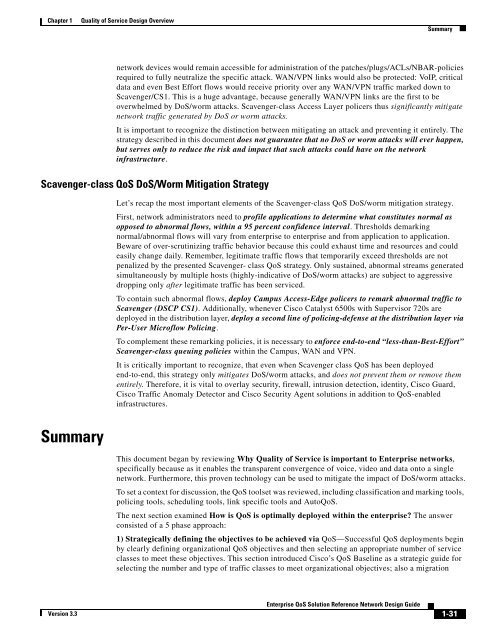Enterprise QoS Solution Reference Network Design Guide
Enterprise QoS Solution Reference Network Design Guide
Enterprise QoS Solution Reference Network Design Guide
Create successful ePaper yourself
Turn your PDF publications into a flip-book with our unique Google optimized e-Paper software.
Chapter 1 Quality of Service <strong>Design</strong> Overview<br />
Version 3.3<br />
<strong>Enterprise</strong> <strong>QoS</strong> <strong>Solution</strong> <strong>Reference</strong> <strong>Network</strong> <strong>Design</strong> <strong>Guide</strong><br />
Summary<br />
network devices would remain accessible for administration of the patches/plugs/ACLs/NBAR-policies<br />
required to fully neutralize the specific attack. WAN/VPN links would also be protected: VoIP, critical<br />
data and even Best Effort flows would receive priority over any WAN/VPN traffic marked down to<br />
Scavenger/CS1. This is a huge advantage, because generally WAN/VPN links are the first to be<br />
overwhelmed by DoS/worm attacks. Scavenger-class Access Layer policers thus significantly mitigate<br />
network traffic generated by DoS or worm attacks.<br />
It is important to recognize the distinction between mitigating an attack and preventing it entirely. The<br />
strategy described in this document does not guarantee that no DoS or worm attacks will ever happen,<br />
but serves only to reduce the risk and impact that such attacks could have on the network<br />
infrastructure.<br />
Scavenger-class <strong>QoS</strong> DoS/Worm Mitigation Strategy<br />
Summary<br />
Let’s recap the most important elements of the Scavenger-class <strong>QoS</strong> DoS/worm mitigation strategy.<br />
First, network administrators need to profile applications to determine what constitutes normal as<br />
opposed to abnormal flows, within a 95 percent confidence interval. Thresholds demarking<br />
normal/abnormal flows will vary from enterprise to enterprise and from application to application.<br />
Beware of over-scrutinizing traffic behavior because this could exhaust time and resources and could<br />
easily change daily. Remember, legitimate traffic flows that temporarily exceed thresholds are not<br />
penalized by the presented Scavenger- class <strong>QoS</strong> strategy. Only sustained, abnormal streams generated<br />
simultaneously by multiple hosts (highly-indicative of DoS/worm attacks) are subject to aggressive<br />
dropping only after legitimate traffic has been serviced.<br />
To contain such abnormal flows, deploy Campus Access-Edge policers to remark abnormal traffic to<br />
Scavenger (DSCP CS1). Additionally, whenever Cisco Catalyst 6500s with Supervisor 720s are<br />
deployed in the distribution layer, deploy a second line of policing-defense at the distribution layer via<br />
Per-User Microflow Policing.<br />
To complement these remarking policies, it is necessary to enforce end-to-end “less-than-Best-Effort”<br />
Scavenger-class queuing policies within the Campus, WAN and VPN.<br />
It is critically important to recognize, that even when Scavenger class <strong>QoS</strong> has been deployed<br />
end-to-end, this strategy only mitigates DoS/worm attacks, and does not prevent them or remove them<br />
entirely. Therefore, it is vital to overlay security, firewall, intrusion detection, identity, Cisco Guard,<br />
Cisco Traffic Anomaly Detector and Cisco Security Agent solutions in addition to <strong>QoS</strong>-enabled<br />
infrastructures.<br />
This document began by reviewing Why Quality of Service is important to <strong>Enterprise</strong> networks,<br />
specifically because as it enables the transparent convergence of voice, video and data onto a single<br />
network. Furthermore, this proven technology can be used to mitigate the impact of DoS/worm attacks.<br />
To set a context for discussion, the <strong>QoS</strong> toolset was reviewed, including classification and marking tools,<br />
policing tools, scheduling tools, link specific tools and Auto<strong>QoS</strong>.<br />
The next section examined How is <strong>QoS</strong> is optimally deployed within the enterprise? The answer<br />
consisted of a 5 phase approach:<br />
1) Strategically defining the objectives to be achieved via <strong>QoS</strong>—Successful <strong>QoS</strong> deployments begin<br />
by clearly defining organizational <strong>QoS</strong> objectives and then selecting an appropriate number of service<br />
classes to meet these objectives. This section introduced Cisco’s <strong>QoS</strong> Baseline as a strategic guide for<br />
selecting the number and type of traffic classes to meet organizational objectives; also a migration<br />
1-31
















